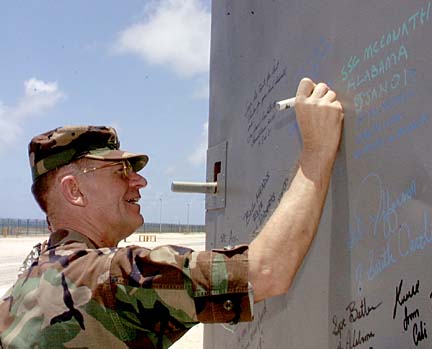


JOHNSTON ATOLL >> Bob Boaldin remembers when he was a captain assigned to this remote outpost in 1977 and the Army would release rabbits into the concrete bunkers to see if it was safe. Johnston Atoll workers
fondly recall their years
on the remote outpostTheir mission was to guard
By Gregg K. Kakesako
America's stash of chemical
weapons in the Pacific
Star-Bulletin"We would put them in," said Boaldin, "and then we would come back the next day. If they were still alive, we knew it was safe."
The Army lost a few rabbits, but Boaldin, a Vietnam War cavalry officer, is not sure if it was the chemical agents that killed them or if they were scared to death from being confined in a dark, cavernous environment.
Boaldin was among the numerous military and civilian workers who attended the decertification ceremony Wednesday for the U.S. Army Chemical Activity, Pacific, which signaled the completion of 30 years of guarding America's cache of chemical weapons in the Pacific.
By September all soldiers of the 250-member unit will have left this remote atoll 825 miles southwest of Honolulu. The Army also has been working to find new jobs for the 26 civilian employees affected by the closure of the unit.
Col. Stephen Brooks, commander of the Army Chemical Activity, said that all but two of the civilian work force have found other jobs or have taken early retirement. He is confident that by the time his unit retires its colors this summer, all of the civilian workers will have new jobs.
David Shogren, chief of engineering, environmental and logistics with the departing chemical activity, said he is lucky because he has been able to transfer to another unit on Johnston.
Shogren, who also is an underwater photographer, said he came to Johnston 12 years ago, planning to work here for two years, but decided to stay on in what he describes as "the best job in the Army.
"You don't see a job like this anywhere else in the world. Folks here loved their job, and you get to do real hands-on work."
Brooks, the unit's 13th and last commander, said his experience in closing two other sites -- one in Germany and another New York -- helped ease the transition.
It has been the mission of his Army chemical unit to guard the enormous stockpile of chemical mustard and nerve gas stored here.
More than 400,000 rockets, projectiles, bombs, mortars, containers and mines amounting to 2,000 tons of nerve agents have been destroyed by another Army agency, the Johnston Atoll Chemical Agent Disposal System (JACADS), according to its project manager, Gary McCloskey.
The last cache of land mines containing nerve agents was destroyed Nov. 29.
Brooks recalled getting "goose bumps" as he watched from the JACADS control room as the last land mine was destroyed.
"We did it with no one getting hurt," Brooks said, "and with no danger to the environment."
The Army, McCloskey said, is now eliminating any waste byproducts resulting from JACADS operations since 1991. Once that is completed, the Army will begin to dismantle JACADS' incinerators, moving to a pullout date three years from now.
Until April 1, Brooks' chemical unit and its predecessor's sole mission had been to guard chemical weapons shipped here from Okinawa beginning in 1971. More was brought in 1990 from West Germany, and another batch a year later from the Solomon Islands.
Boaldin left active duty in 1979 and joined the staff at Fort Shafter, where he is now a nuclear chemical weapons specialist for the Army's Pacific area.
"There were only 99 beleaguered souls back then," Boaldin recalled about the early days at Johnston Atoll. At the peak of the JACADS chemical weapons destruction program, Johnston hosted a population of more than 1,200.
McCloskey said his effort will be focused on the $412 million cleanup effort.
"The message I have been getting from the public is simple: We wish this didn't have to happen, but since it did, we want you folks to clean it up and be done with it."
In 1990 the United States stockpiled 30,000 tons of chemical agents, McCloskey said. Of that amount, nearly 7 percent was here.
By 2000, 22 percent of these deadly weapons had been destroyed, according to Lt. Gen. Paul Kern, deputy to the assistant secretary of the Army for acquisition, logistics and technology.
The Army and the Air Force, which is the landlord for this atoll, is charged with cleaning up the environment and removing buildings to meet the scrutiny of the U.S. Environmental Protect Agency and the U.S. Fish and Wildlife Service, which has been responsible for the marine and bird refugee here since 1926.